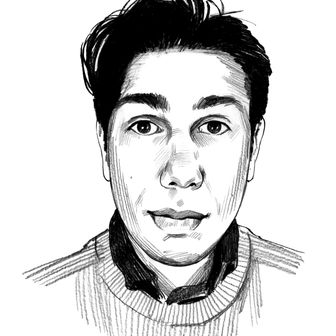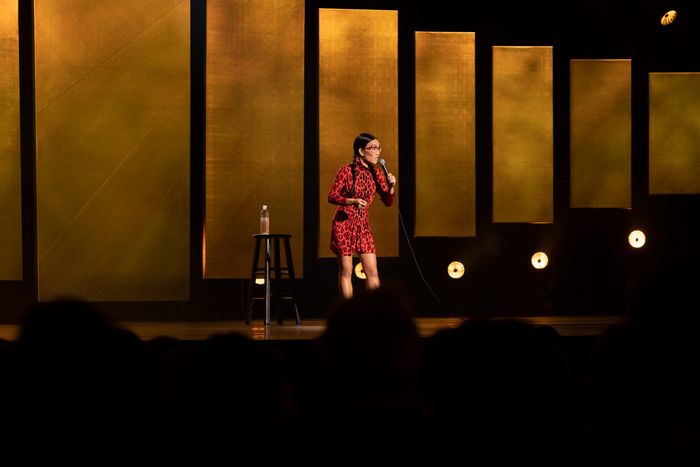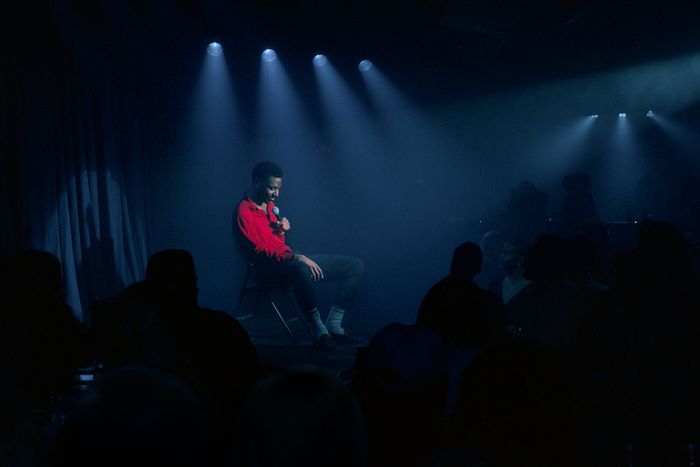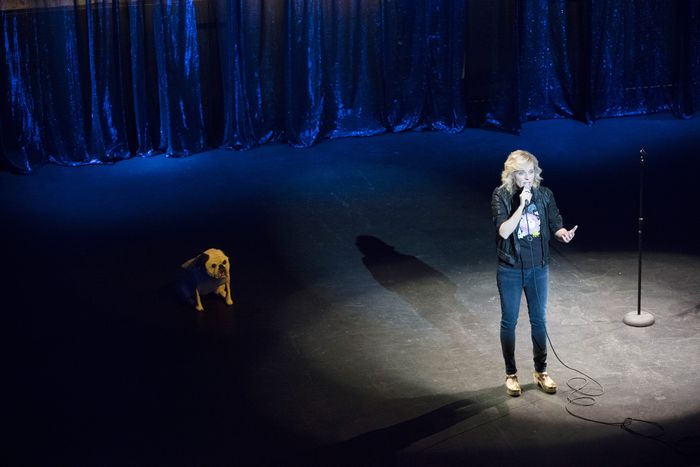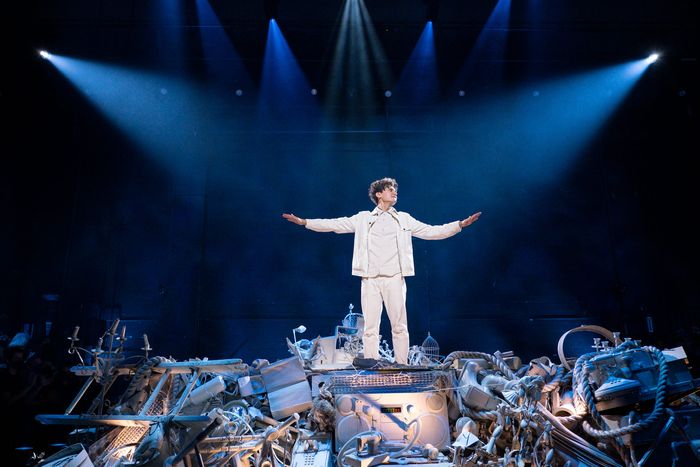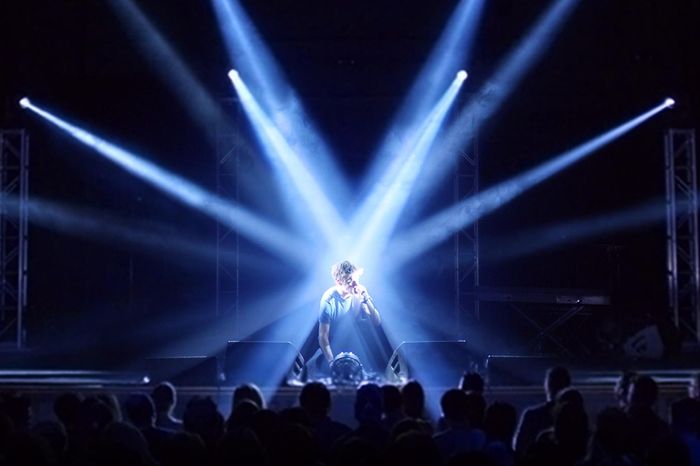
It’s natural to skip past the end credits on a comedy special without thinking about the people credited within them. Platforms like Netflix practically encourage this behavior, taking you back to the navigation menu moments after the comedian has finished waving to the crowd. Linger on them for a little longer, however, and you’ll see the hundreds of artists and craftspeople responsible for bringing comedy specials to life. They’re producers who manage hiring and logistics, cinematographers and production designers who marry comedians’ content to their aesthetics, and sound mixers and editors who refine live performances into polished products.
To learn more about how these professionals approach their crafts, Vulture interviewed a group of five behind-the-scenes figures who’ve made invaluable contributions to the comedy specials we consider technical achievements today. They’ve lent their expertise to productions like Jerrod Carmichael’s Rothaniel, Bo Burnham’s Make Happy, Adam Sandler’s 100% Fresh, Chris Rock’s Tamborine, Maria Bamford’s Old Baby, Chelsea Peretti’s One of the Greats, Drew Michael’s Red Blue Green, Moses Storm’s Trash White, and more. They spoke about the challenges of producing comedy in a time of higher demand but lower budgets, revolutionizing the way stand-up can look on-camera, and doing their jobs so well that their contributions go unnoticed.
The Luxury of Two Days
Emily Cohen is a line producer who’s worked on over ten comedy specials, including Ali Wong’s Don Wong, Ramy Youssef’s Feelings, and Anthony Jeselnik’s Fire in the Maternity Ward.
My role depends on the production company and if they want me to be the money person or the money person and the creative person. The very first thing that happens is the budget. I need to talk to everybody — especially the production company — about how they and the network want us to spend the money. Then, if we’re “staging” the show — if the artist isn’t on tour and we’re finding a venue and staging it from the ground up — I’ll look for venues. From there, it’s building a team: hiring the designer, the director, and the lighting designer. Then it’s presenting an idea and bringing it to fruition. Sometimes the artist is engaged in the decision-making process of who the set designer is, who the lighting designer is, who the director is, and who the director of photography is. The comics learn fast what they like and what they don’t like.
One of the challenges I see evolving is that the supply and demand for comedy specials is changing, and now these distributors want production companies to do it for less money and in a shorter amount of time. I’ve done a comedy special called a “one-day wonder,” where you load in the set, lights, sound, cameras, shoot two shows, and strike all in one day. Back in the old days, you had a week to shoot a comedy special. Now, two days is a luxury.
COVID has been the biggest challenge of my career. I was slated to do a Netflix comedy special in 2019. We got as far as doing a scout, which is where the key people go to the venue. Then the pandemic happened. Then we had an attempt No. 2, and we had an attempt No. 3, and finally we just shot it in November in New Jersey. The biggest obstacle was that the artist did not want the audience to wear masks. So we had to work out how to do that with the blessing of all the unions and their strict COVID protocols.
Shooting comedy is not as easy as it looks. It’s a skill set, and it takes a village to move a mountain. Because of that, sometimes there’s a lack of production value, there’s a lack of richness in the set or a lack of richness in lighting. If you go back and look at old comedy specials, they put a lot of money into them. We did a live Brian Regan special from Radio City, and we were there for a couple of days, and you can really see the difference in money spent. But most average viewers don’t notice, and the digital platform distributors know that, so they don’t really invest much. At that point, it’s on the artist to maintain their own brand and sensibility, to fight for an elegant set or sophisticated lighting.
A Beautiful, Choreographed Dance
Andrew Wehde is a cinematographer who’s worked on over ten comedy specials, including Drew Michael’s Red Blue Green, Bo Burnham’s Make Happy, and Chris Rock’s Tamborine.
When I work on projects in the comedy world, I tend to join fairly early on in the process. I try to get the comedian to explain as simply as possible what it is that they’re trying to accomplish. A lot of making sure their work feels classic and timeless comes from steering them into the simple approach; simplicity doesn’t mean it needs to look cheap, either. Sometimes I’ll ask if they have any visual inspirations. Like, with Drew Michael’s Red Blue Green, we looked at Inside Llewyn Davis as an example of tone, color, and lighting. When we worked with Chris Rock, though, he’d seen Jerrod Carmichael’s 8, and so he called Bo Burnham and was like, “I want you guys to make my special. I don’t care what you do. I have no creative input. I’ll just show up and let’s do it.” At that point, Kanye West was on a tour where he was doing these beautiful light-grid concerts, and we really vibed off the idea of giving Chris more light than you could possibly have but creating contrast so it still felt dark. We had about 140 vintage tungsten can movers that we found in storage that don’t exist anymore. They’re the most beautiful, rich, warm lights, and we ran this huge beautiful grid array, where Chris basically had no spotlight. and he just walked in and out of light for the whole special.
During planning, I’ll usually do two different technical drawings: one that states where the cameras will go and what kind of lensing they have, and I’ll start designing a rudimentary idea of what the lighting will be. Then I’ll do a semi-technical drawing that I can distribute to producers. After that, the preparation is really on-site and just hoping that the camera placements that you had envisioned were right. The real difficult part of it is fine-tuning lighting levels to the camera so it doesn’t feel like a late-night show. I try to really push the camera to its maximum low-light ability and bring down a lot of my stage lights as low as possible so that everything clicks and feels better. Sometimes we’ve had it where after a half-hour of looking at things, it looks great. Other times, like with Make Happy, we spent two full days going through every single lighting cue.
The greatest challenge is capturing what is essentially a legitimate movie live in front of an audience with anywhere from five to ten cameras, and doing it in a way that can be edited in a unique, story-driven manner. Of the many mediums I work on — TV, film, and commercials — making a live comedy special is hardest of all. Sometimes we have to do things in a way that’s never been done before. Attempts to shoot in the round have been really unsuccessful in comedy for decades. When we were shooting Jerrod Carmichael’s 8, Bo was adamant that we needed to figure out how to do it in a way that the audience doesn’t get lost. That’s what used to happen — the viewers wouldn’t know where they were, and they didn’t know where the talent was. We basically built a circle track around the entire perimeter of the venue and ran three dollies, and each dolly had two cameras, which I called dual-headed monsters. That way, each camera on each dolly had really big zooms on it, 24-mm. to 300-mm. If one camera was zooming in, the other camera was zooming out, so you had the ability to intercut the same angle at any time from three different sections while they’re moving. It became a really beautiful choreographed dance.
I think we’re at a fork in the road right now. There’s going to be your overproduced-looking specials, which are very bright and overly lit with bizarre out-of-focus lights in the background and big swooping camera moves. And don’t get me wrong, I’ve had to do those a couple times because I don’t always get to do what I want. And then it’s going to be more things like the Bo, Jerrod, and director-producer Chris Storer stuff, which are going to be much rawer and more intimate.
The Pursuit of One Perfect Atmosphere
Marc Janowitz is a lighting and production designer who’s worked on over 15 comedy specials, including Jerrod Carmichael’s Rothaniel, Bo Burnham’s Make Happy, and Adam Sandler’s 100% Fresh.
My involvement depends a lot on whether I’m being brought in as a lighting designer only or if I’m being brought in as a production designer and lighting designer, which is a combination you don’t often see. Generally the producer who’s calling me will give me a rundown of whatever has already been discussed. It’ll be something like, “The comedian really wants to perform in front of something that feels like a star field.” Then I’ll ask the artist a series of questions about visual references they find interesting, or things that they’ve seen before. From there, I’ll sketch out some ideas and create an idea board of visual references and structures I think are cool. We’ll engage in a little more dialogue, and then I’ll make some more sketches and renderings until we arrive at the final rendering.
With most of the comedy specials I’ve been involved in, the model is that you spend a lot of time beforehand crafting the perfect look where it’s going to be great for every camera angle and going to edit well together across two to four shows. Sometimes, we need to account for whether the comedian is very active onstage: Are they going to make it all the way to the edge of the stage where we need something in the background for a cross-shot? The venue can also play a role: If it’s a proscenium theater with a big stage, lots of seating, and lots of rigging positions you have enough space to put your staging. But for something like Jerrod Carmichael’s 8, for instance, that venue was the production design. The challenge then became adapting the venue’s personality to what we were trying to do.
When I work on a rock show, a band like My Morning Jacket will play 30 songs a night. Within every song, it’s going to be very dynamic, and you’re looking for lots and lots of wow and aha moments. It’s an intense two and a half hours — boom, boom, boom, boom, lights everywhere, and then it’s done. A comedy special is completely the opposite version of that, where you are attempting to create one perfect atmosphere using the lighting design, art design, and production design that works for the comedian and the audience in the room.
When I worked on Hasan Minhaj’s special Homecoming King, the biggest unknown was: How would the cameras interact with the LED video walls that made up the set? There’s an inherent challenge with the matrix of little dots on an LED wall and the matrix of dots that are in a camera sensor. If the cameras are too focused on the LED wall display, you get a really terrible moiré pattern, which is unacceptable for broadcast. Ultimately, the solution became a combination of making sure you had the tightest pixels you could pack on the LED wall combined with enough distance between the comedian and the wall to allow for the cameras to get just the slightest soft focus. So you’re seeing all the imagery, but the sensor is not picking up on the grid pattern.
One of the things that has been eye-opening for me, and something you can really embrace with comedy specials, is that there are certain moments where you know which camera is going to make the cut, so you can make these little lighting tweaks where you’re breaking all the rules that exist in live settings. In those moments, you can tweak the light just a little bit to create a flare, or you can elbow the director of photography next to you and tell him that if he just tilts up a little bit, he’ll see a corona lighting effect. Those are some of the magic moments.
Just Smooth It With Laughter
Brenda Carlson is a video editor who’s worked on over 170 comedy specials, including Maria Bamford’s Old Baby, Bo Burnham’s what, and Chelsea Peretti’s One of the Greats.
Usually I’ll get called in after comedians have already finished shooting their specials. They usually shoot two shows, so they’ll tell me which show they preferred, and I’ll use that as my base while still looking at both shows to combine the best from each.
I have a process of how I tackle things. I go through and grab audience audio from the show for laughs, because if you switch between shows for an edit, you use laughter to make it feel smooth. I pull audience reactions if there are audience reactions. Then I go through both shows and I string it together based on what parts got the best response, what had the best performance, which shots had the best angles, and where there were no flubs. A lot of times I can clean up a flub within the show. I can grab a word and insert it somewhere if they messed up to correct it. Or if they said something twice, I can just go to a different angle and cut that out.
Maria Bamford’s Old Baby was a very unique one to work on. The audiences got bigger and bigger throughout, and she did her whole act to every audience in every location, so I had all that footage and we had to work on where to make the transitions.
I like it when comedians are hands-on with the edit. I’ve worked with so many great comedians, and sometimes we’ll watch it through together and they’ll give notes. With other people, like Bill Burr, I remember he hated watching himself, so he’d come in for a few seconds at a time, give a few specific notes, and then leave.
Bob Saget was very involved in the edit because his shows were very, very different. Usually when a comedian shoots two shows, they have a script and a setlist and they do pretty much the same jokes in the same order, give or take two or three. Bob had a few jokes he made sure to hit in both shows, but they would be in different orders because his act was very much dependent on crowd work. That made it really challenging to get the best of both shows.
One of my favorite compliments I’ve ever gotten from a comedian was from Tiffany Haddish. She told me I was the Beyoncé of editing.
Coughs and Sneezes and Evil People
Michael Farnan is a rerecording mixer who’s worked on over 15 comedy specials, including Moses Storm’s Trash White, Seth Meyers’s Lobby Baby, and Norm Macdonald’s Hitler’s Dog, Gossip & Trickery.
My role on a special typically starts right at the end after the show has been recorded and edited. I take all the recordings from the production recordists at the venue, get the editor’s cut of the show, and it’s my job to mix it all together. We mix in surround sound, so the venue can have anywhere from 12 to 30 different microphones to capture the crowd. The production recorders will make what’s called a “sound report,” where they show where all the microphones are in the theater relative to each other, so I know where to place them in the sound field so that everything lines up properly and remains in phase.
I spend a significant amount of time editing out extraneous noise from the crowd. Live crowds are messy; you get everything from coughs and sneezes to evil people who talk back during a show that they know is being recorded. Occasionally a microphone will go bad, or sometimes somebody will bump a microphone at a key moment. Even something like a comedian’s microphone technique can make a difference. Some comedians are better at holding the mic, and some are not as careful.
Once I’ve done my mix, we’ll play it back for a comedian — or sometimes it’s their manager who’s involved — and they’ll give me whatever notes they have. For the most part, it’s fun to work with them. Some give absolutely fantastic notes, although some get a little nitpicky. It wasn’t strictly stand-up, but I worked on the Middleditch and Schwartz
improv specials, and Ben Schwartz gave some of the best, most detailed notes I’ve ever gotten on any type of project. That show was an interesting challenge because they weren’t just standing at a microphone, they were literally running around the theater as they were performing. They were wearing lavalier body microphones, switching between the microphones as they were talking, and a lot of times talking over each other. It was very challenging to balance their microphones in a way that sounded natural.
I also did one show during the pandemic with Marlon Wayans that was shot outside, and it happened to be underneath the flight path in Miami, so there were jets sailing over the show. I had to use a lot of sophisticated noise-reduction software.
Moving laughter is somewhat of a sensitive topic with comedians, but we do what’s called “sweetening.” We have a guy who specifically works on laughs. He samples clean laughs from the show and then we sit there, watch the show, and add in laughs and chuckles here and there. But it’s all very subtle. We don’t want to do anything to make it sound like an ’80s sitcom — it’s really just to smooth out the various edits. It’s usually not a case of adding in a laugh where there was no laugh.
In general, there’s a big challenge with how loud you mix the laughs. Some comedians want it to be a little more subtle, and some want the laughs to be really loud. As a philosophy, I always say, What would this sound like if I was sitting about five or six rows back in the live audience myself? There’s always that cliché in my line of work that’s like, “If people notice your work, you’re not doing it right.”
Interviews have been edited and condensed for clarity.
More From This Series
- What Do Comedians Think of (the Non-Joke Parts of) Stand-up Specials?
- Michael Bonfiglio Wants to Tell You a Story
- I Sat Front Row at Maria Bamford’s Comedy-Special Experiment


